Photovoltaic generators use the semiconductor properties of the materials they are made of. Photovoltaic solar cells are semiconductors that are able to convert light into electric direct current (DC, meaning non time-varying current). Current goes through an inverter which converts DC into AC that is used in electric appliances (figure 1). Current generated in excess by the panels and not used in electric appliances is released into the utility grid, if the system is connected to it.
Photovoltaic panels
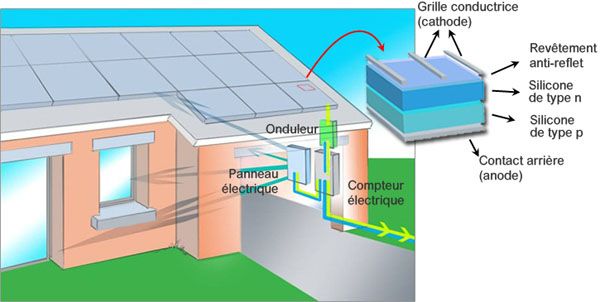
Magnetic field intensities around a photovoltaic system
In this example, let us consider 16 collectors assemblies (assembled in series). Its max power is around 5200 W (monocrystalline silicon solar cells, DC 9A).
1. Near the line between the panels and the inverter
An approximate idea of the value of the magnetic induction field can be estimated by the following formula:
B (en Tesla) = µ . i / (2 . pi . r)
where
µ is the permeability of free space (see Glossary – Magnetic permeability)
i (in A) = the current through the panels
pi = 3.14
r = the distance from the line
Thus using the data, it is around 1.8 microTeslas (µT) 2m away from the panels. It is a DC magnetic field. As a comparison, the earth’s magnetic field, also constant in time, is around 40 µT at our latitudes (50° north).
2. Near the inverter
Here are values measured around the inverter (Table 1).
Table 1 – 50Hz magnetic field values measured at various distances (3 different days)
(For the “0 cm” measurement, the field probe was placed right next to the inverter,
where the measured fields were the highest)
| Day 1: Power around 700 W |
Day 2: Power around 2000 W |
Day 3: Power around 4000 W |
||||
|---|---|---|---|---|---|---|
| Distance (in cm) |
50Hz MF (µT) |
Power (W) |
50Hz MF (µT) |
Power (W) |
50Hz MF (µT) |
Power (W) |
| 0 | 45 | 680 | 165 | 2400 | 280 | 4326 |
| 30 | 0.8 | 720 | 2 | 2075 | 3.8 | 4000 |
| 60 | 0.15 | 730 | 0.31 | 2062 | 0.76 | 4230 |
| 90 | 0.045 | 720 | 0.23 | 4125 | ||
With these measurements, we can state that at around 1 m of the inverter when these panels are delivering their maximum capacity, magnetic field intensities fall below 0.4µT.
Here is a graph (Figure 2) showing the variations of magnetic field intensities from 10.37 AM to 5.02 PM (probe at 50 cm of the inverter). The highest values occurred in the morning, as the panels are oriented to the East. Fluctuations are related to decreases in electricity production (see ‘red dots’) when clouds were shading the panels.
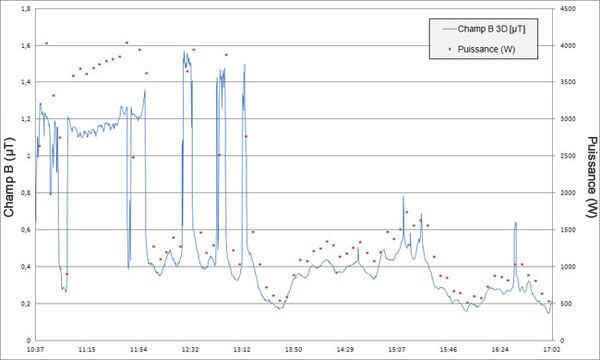
Figure 2 – Variations of magnetic field intensities (B-field in µT, recording every 16 s.)
and power delivered (in W, recording every 5 min.) according to time
3. Near the supply line to the electric meter
Inverters are often placed near electrical panels meaning that the length of the supply line inside the home is often very short. With a capacity of around 2000 W, we measured a nearby magnetic field of 5.5 µT (probe by the line), which rapidly falls to 0.4 microtesla beyond a few tens of cm (0.185 µT at 30 cm).
How do panels convert light into DC?
The word “photovoltaic” refers to the energy of the photons of light that is used to produce a voltage.
When photons hit a semiconductor, energy released excites electrons into a higher state of energy. The flow of energized electrons carries electrical energy.
Semiconductor materials such as silicon in their neutral state are not immediately and solely by themselves able to generate an electric current. In fact, they must contain impurities, which is done through a process called “doping”. Here is how it works:
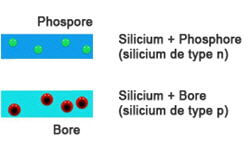
“Doping” means that elements are introduced into silicon layers to create a globally negative charge with electrons in excess (n-type silicon) or a globally positive charge with holes in excess (p-type silicon).
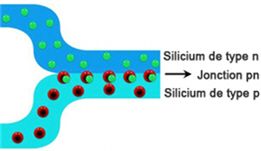
When both types of silicon are put in contact,
a pn junction is created, that is a space where free charges (electrons and holes) are recombining.
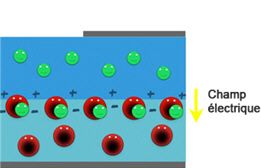
The recombination of free charges (electrons and holes) generates an intrinsic potential difference (electric field) around the pn junction.
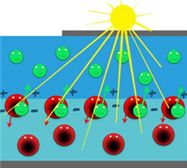
With the photon’s energy, electrons are freed and the electric field forces them to move to the n-type silicon
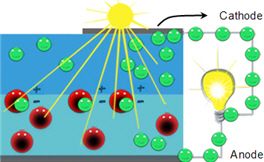
To recover their steady state, the flow of energized electrons has to go through the electrical wires, from the cathode to the anode.
It results in a direct electric current which is transformed in time-varying current in the inverter. This can be used to supply electrical devices (a light bulb in this illustration).
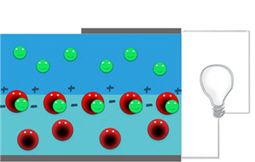
Without photon’s energy, solar cells come back to their steady state.
Documents & Links
Topics that might interest you ...
- Electrical concepts – Electrical concepts interesting to have in mind in order to tackle the subject of electromagnetism and electric and magnetic fields without apprehension.
- Electric and magnetic fields – The electric and magnetic fields are distinct concepts that were developed to explain the effects of electricity at a distance. (…)
- Electromagnetism – Electromagnetism is the study of charge interactions at a distance, of currents and electric and magnetic fields. (…)
- Uses of EM properties – How do common domestic electrical appliances work? Based on various examples, we should gain an overall understanding of the operating principle behind those machines that convert electrical energy into thermal or mechanical energy or otherwise make use of electrostatic and electromagnetic properties.
- Electricity network – How does the electrical grid work? All you would like to know about the transmission of electricity from power plant to the outlet on our walls.


